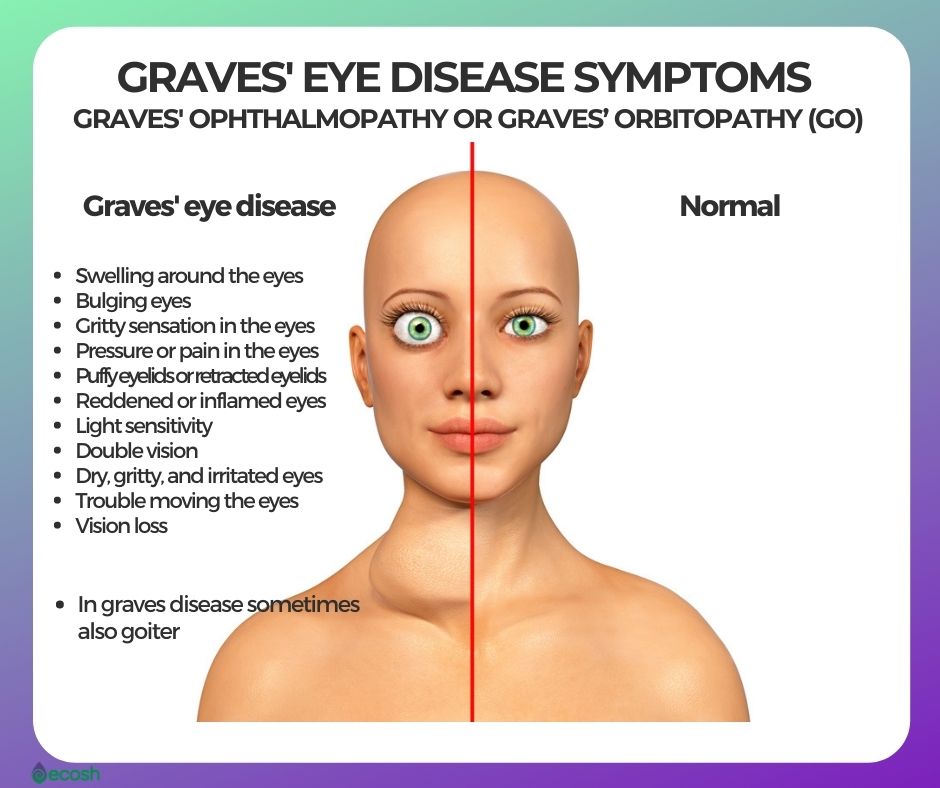Nursing Paper Example on Graves’ Disease
Nursing Paper Example on Graves’ Disease
Graves’ disease is an autoimmune disorder and the most common cause of hyperthyroidism. It occurs when the immune system produces autoantibodies that stimulate the thyroid gland, leading to excessive production of thyroid hormones. This hormonal imbalance affects various bodily functions, including metabolism, heart rate, and thermoregulation. Graves’ disease can present at any age but is most prevalent in women aged 30 to 50. Early diagnosis and treatment are essential to manage symptoms and prevent complications.

Causes
Graves’ disease is caused by the production of thyroid-stimulating immunoglobulins (TSI), which mimic thyroid-stimulating hormone (TSH). These autoantibodies bind to TSH receptors on thyroid cells, prompting the gland to overproduce thyroid hormones.
Although the exact trigger remains unknown, genetic predisposition and environmental factors play significant roles. Stress, infections, and pregnancy are known to exacerbate immune dysregulation, contributing to the onset of Graves’ disease. A family history of thyroid disorders or autoimmune conditions also increases the likelihood of developing the disease.
Signs and Symptoms
Graves’ disease presents with various symptoms due to hyperthyroidism. Common signs include unexplained weight loss, heat intolerance, and increased appetite. Patients may experience palpitations, sweating, and fatigue due to the overactive metabolism. Neurological symptoms such as tremors, anxiety, and irritability are frequent.
Ocular manifestations, known as Graves’ ophthalmopathy, include eye bulging, redness, and double vision. In severe cases, skin thickening on the lower legs, termed pretibial myxedema, may occur. The intensity of symptoms varies among individuals, with some presenting mildly and others severely.
Etiology
The etiology of Graves’ disease involves immune system dysfunction. The primary autoantibody implicated is thyroid-stimulating immunoglobulin, which disrupts normal thyroid regulation. Genetic factors, including specific human leukocyte antigen (HLA) types and other immune-regulatory genes, predispose individuals to the disease.
Environmental triggers such as smoking, infections, and high iodine intake have been linked to the onset of Graves’ disease. Hormonal fluctuations, particularly in women, are also believed to influence disease development and severity.
Pathophysiology
Graves’ disease results from the interplay between genetic susceptibility and environmental triggers, leading to autoimmune activation. The thyroid-stimulating immunoglobulin activates the TSH receptor on thyroid cells, causing unregulated thyroid hormone synthesis and release. Excess thyroid hormones amplify metabolic activity and enhance sympathetic nervous system sensitivity. Graves’ ophthalmopathy arises from the autoimmune attack on orbital tissues, leading to inflammation and fibrosis. Pretibial myxedema occurs due to the deposition of glycosaminoglycans in the dermis.
Diagnosis
Graves’ disease diagnosis combines clinical evaluation, laboratory tests, and imaging studies. Blood tests reveal elevated free thyroxine (T4) and triiodothyronine (T3) levels, with suppressed TSH levels. Thyroid-stimulating immunoglobulin or TSH receptor antibody tests confirm autoimmune activity.
A radioactive iodine uptake scan demonstrates diffuse thyroid gland overactivity. Ultrasound may identify thyroid enlargement and increased vascularity. A comprehensive assessment helps distinguish Graves’ disease from other causes of hyperthyroidism, such as toxic nodular goiter.
Treatment Regimens
Treatment options for Graves’ disease aim to control hyperthyroidism, alleviate symptoms, and address autoimmune activity. Antithyroid medications such as methimazole and propylthiouracil reduce thyroid hormone production. Beta-blockers like propranolol manage cardiovascular symptoms, including palpitations and tachycardia. Radioactive iodine therapy destroys overactive thyroid tissue, leading to a reduction in hormone production.
In some cases, thyroidectomy, the surgical removal of the thyroid gland, is performed. For Graves’ ophthalmopathy, glucocorticoids and orbital decompression surgery may be necessary in severe cases.
(Nursing Paper Example on Graves’ Disease)
Patient Education
Patient education is crucial for effective management of Graves’ disease. Individuals should understand the chronic nature of the condition and the importance of adhering to treatment plans. Regular follow-up visits are essential for monitoring thyroid hormone levels and adjusting therapy. Patients should be informed about potential side effects of treatments, such as hypothyroidism following radioactive iodine therapy.
Lifestyle modifications, including stress reduction, avoiding smoking, and maintaining a balanced diet, support overall health and may reduce symptom severity.
Research and Future Directions
Ongoing research on Graves’ disease focuses on understanding its genetic basis and immune mechanisms to develop targeted therapies. Advances in biologics targeting specific immune pathways, such as monoclonal antibodies, show promise in reducing autoimmune activity.
Studies exploring the role of gut microbiota in immune regulation may provide new insights into disease prevention and management. Improved diagnostic tools for early detection and risk assessment are also under investigation.
Conclusion
Graves’ disease is a complex autoimmune disorder with diverse clinical manifestations. Its pathogenesis involves genetic and environmental factors, leading to unregulated thyroid hormone production. Early diagnosis and tailored treatment strategies are essential for managing symptoms and preventing complications. Advances in research continue to enhance understanding and provide hope for improved therapeutic options in the future.
References
Davies, T. F., & Larsen, P. R. (2022). Thyroid hormone synthesis and secretion. New England Journal of Medicine. https://www.nejm.org
Smith, T. J., & Hegedüs, L. (2023). Graves’ disease: Pathophysiology and treatment approaches. Lancet Diabetes & Endocrinology. https://www.thelancet.com
Bahn, R. S. (2020). Graves’ ophthalmopathy. New England Journal of Medicine. https://www.nejm.org
Antonelli, A., Ferrari, S. M., & Fallahi, P. (2021). Environmental triggers in Graves’ disease. Autoimmunity Reviews. https://www.sciencedirect.com
Cooper, D. S., & Ross, D. S. (2023). Antithyroid drugs in the treatment of Graves’ disease. Journal of Clinical Endocrinology & Metabolism. https://academic.oup.com



